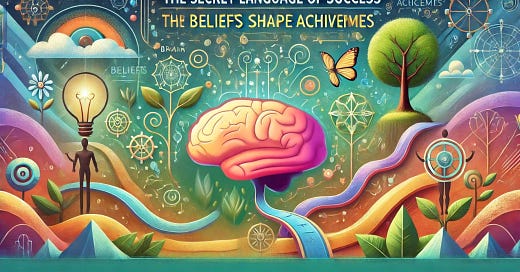Today, let’s talk about something amazing. This will be about that hidden superpower, that all those high achievers, who you admire, have been using, often without even realizing it. It seems it’s the secret sauce that turns those ordinary folks into world-changers. And the best part here? That you have all of this too.
Welcome to the wild and wonderful world of beliefs — the silent script running in the background of your mind, which is shaping your reality in ways you’ve never imagined.
Now, I know what you might be thinking. “Beliefs? Really? Isn’t that just some fluffy self-help nonsense?”.
Oh boy, are you in for a surprise! We’re not talking about wishful thinking here or staring at yourself in the mirror, while chanting affirmations (though hey, if that’s your jam, it’s you do you). We’re going deep into the nitty-gritty of how your brain works, how top performers think and how you can step into this incredible power by yourself.
And by the time when we would it done, you’ll never look at your thoughts the same way again.
The Invisible Force Field - How Beliefs Shape Your World
Now let’s start with a little experiment first. Close your eyes for a moment (well, after you read this paragraph) and imagine that you’re about to give a speech in front of a huge crowd. And I mean, really put yourself there — feel that spotlight, hear the murmur of the audience, feel those eyeballs on you. Now, pay attention to what your mind is telling you. Is it saying “You will be totally awesome! They’re going to love you!”, or is it more along the lines of “Oh no, I’m certainly going to mess this up. And they’ll all laugh at me.”.
Those thoughts? They’re not just a random noise. They are your beliefs in action and they’re shaping your reality more than you know.
You see, our beliefs act like a force field around us, they are filtering how we perceive the world and are influencing us, how we act in it. They’re like the operating system of our minds, constantly running silently in the background and affecting everything we do.
Let’s break this down with a real-world example. Let’s meet Vicky and Lisa, two equally talented software engineers.
Vicky believes that she’s “not good with people” and “just a tech geek”. When a leadership position opens up at her company, she doesn’t even consider applying to it. She just tells herself, “That’s not for people like me”.
Lisa, on the other hand, believes that she is “always learning and growing” and that “tech skills and people skills aren’t mutually exclusive”. So when she saw the same leadership opening, she thinks, “This could be a great opportunity to stretch myself more!”.
Same situation, same skill level, but wildly different responses — all because of their beliefs.
Now, here is where it gets really interesting. These beliefs don’t just affect their decisions in that moment. They shape also their entire career trajectories.
Vicky, who believes that she’s “just a tech geek”, focuses solely on technical skills. She avoids team projects and networking events. Over time, she became isolated at work and was also missing out the opportunities for growth and collaboration.
While Lisa, with her belief in continuous learning, seeks out projects that challenge and expand her further. She attends industry events, makes connections and gradually builds a reputation as someone who can bridge the gaps between tech and business needs.
Fast forward five years and their careers look completely different. Lisa is in a senior leadership role, while Vicky, despite her technical brilliance, feels as stuck and undervalued.
The kicker? Their initial beliefs became self-fulfilling prophecies. Vicky’s belief that she wasn’t good with people led her to avoid social situations, which meant she never improved her interpersonal skills — thus “proving” her initial belief correct. Lisa’s belief in her ability to grow, led her to seek out challenging situations, which helped her to develop new skills — again, “proving” her belief correct.
This is the power of beliefs. They’re not just thoughts in your head — they’re indeed the architects of your reality.
But here’s the million-dollar question - Where do these beliefs come from? And more importantly, can we change them?
Hold that thought, because we’re about to go into the fascinating world of belief formation. And trust me, what you’re about to learn, might just blow your mind…
The Birth of a Belief - From Whisper to Roar
Alright, let’s play detective for a moment. We’re on the hunt for the origins of your beliefs. It’s like that trying to find the source of a mighty river — you have to trace it back to the tiniest trickle.
Your beliefs didn’t just pop into existence fully formed. They’ve been shaped by a lifetime of experiences, influences and interpretations. Some of them you consciously chose, but many — especially the most powerful ones — those snuck in when you weren’t looking.
Let’s break this down:
Early Experiences - Do you remember how it was, when you were a kid and everything was new and exciting? Well, your brain was like a sponge back then, soaking up information and forming conclusions at lightning speed. If you tried something new and succeeded, your brain might made the belief “I’m good at trying new things”. And if you failed and people laughed, you might have stored “It’s dangerous to take risks”.
Family Dynamics - The way your family talked about success, money, relationships and self-worth laid the groundwork for many of your core beliefs. Did your parents often say “money doesn’t grow on trees”? That might be influencing your financial beliefs even now.
Cultural Messages - The society and culture where you grew up in, have been sending you thousands of messages about what’s possible, what’s expected and what’s “normal” for someone like you. These messages seep into your subconscious and are becoming beliefs without you even realizing it.
Personal Interpretations - Here’s where it gets really interesting. Two people can go through the exact same experience and come away with completely different beliefs. Why? Because it’s not the experience itself that forms the belief — it’s how you interpret it. And that is VERY important.
Let’s look at an example. Here are twins, Jack and Jill (yes, I know, but stick with me here). When they were 10, they both tried out to get a role in school play. Neither of them got a part.
Jack interpreted this as “I’m not good at acting. I should stick to sports”. This belief led him to avoid any performance-related activities in the future.
Jill, however, thought: “I need more practice. Maybe I’ll join the drama club and try again next year. And I’m sure I will get it that time”. This belief spurred her to work on her skills.
Same experience, wildly different beliefs, and after that totally different paths in life.
Now, here’s the really cool part. Once a belief is formed, your brain starts looking for evidence to support it. It’s like if your mind would become a detective, but one with a serious confirmation bias.
So if you believe that you’re bad at math, your brain will probably highlight and remember every mistake which you ever made and downplay your successes. Forgot to carry the one? “See, I told you I was terrible at this!”. Or when you solve a complex equation? “Oh, that was just luck, I’m not good at it!”. =:-O
This is how even such a tiny belief, which was formed in a single moment, can grow later into a major force which is shaping your life. It’s like a snowball rolling down a hill, while gathering more and more snow (evidences) as it goes, until it becomes an unstoppable avalanche.
But — and this is important — just because a belief has become big and powerful, doesn’t mean it’s true or unchangeable.
Remember our friends Jack and Jill? Fast forward 20 years. Jack, despite his early belief, that he is not good at acting or in performance-related activities, found himself then in a job that required public speaking. He was terrified at first, but he was forced to practice. To his surprise, he discovered later, that he actually had a knack for it. His old belief began to crumble, replaced by a new one: “I can learn new skills if I put in the effort, and so I can be great also in public speaking”.
Jill, on the other hand, she became a successful actress. But her belief in the need for constant practice turned into perfectionism. She started to believe that “I’m only as good as my last performance”, leading to anxiety and burnout. And that didn’t make her happy as she thought she would be.
And the point? Beliefs are powerful, but they’re not set in stone forever. They can change — if you know how to change them.
And that, my friend, is exactly what we’re going to explore next. So get ready, because you’re about to learn how to become the master architect of your own beliefs — and by extension, also the master architect of your own life.
But first, take a moment to reflect. What beliefs have been shaping YOUR life? Where did they come from? Are they serving you well or they are holding you back?
Grab a pen and write down few key beliefs that you have about yourself. Don’t judge them, just observe. To be aware of them is important because that’s the first step to making a change.
OK, are you ready now, to go even deeper into the art and science of belief transformation? Then let’s go!
The Belief Renovation Project - Remodeling Your Mental Home
Imagine now your mind as it’s a house. Your beliefs are the foundation, the walls and the roof. They determine also what you see when you look out through the windows, what comes in and what stays out.
Now, imagine that you’ve been living in this house for your whole life. You’re so used to it that you don’t even notice those cracks in the walls, the leaky faucets, the outdated decor. But what if I tell you, that you can renovate this mental home? That you can knock down these limiting walls, install big picture windows of possibility and build also a rooftop terrace of your dreams?
These all sound great, right? But where do you start? Don’t worry, I’ve got you covered here too. Here’s your step-by-step guide to renovate your beliefs:
1. The Belief Audit:
It’s time to take stock. Grab that list of beliefs which you wrote down earlier. Now, for each one, ask yourself:
- Is this belief based on fact or is it just an assumption?
- Where did this belief come from? Is that source reliable?
- How is this belief affecting my life? Is it helping me or it’s hindering me?
- If a friend would hold this belief, what would I tell them?
2. The Demolition Phase:
Did you identify a belief that’s not serving you well? Then it’s time to break it down. Challenge it. Look for evidence that contradicts it. For example, if you believe “I’m not creative”, recall then those times when you’ve come up with unique solutions or ideas.
3. The Reconstruction:
Now for the fun part — building new, empowering beliefs. For each limiting belief which you demolished, build a new one that would serve you better. But here’s the key: make it believable. So if you’ve always thought that you’re terrible at public speaking, jumping straight into “I’m the world’s best orator” is a bit too big leap. Start rather with something like “I can improve my speaking skills with practice and I’m going to be better and better”.
4. The Daily Maintenance:
A belief isn’t rebuilt in a day. It takes consistent effort. So find ways how would you reinforce your new belief every day. If you’re working on believing that you’re confident, then stand tall, smile at strangers, voice your opinion in meetings. Act as if the new belief is already true.
5. The Evidence Collection:
Remember how does your brain love gathering evidences? Use that to your advantage. Keep a “belief evidence journal”. Every day, write down one piece of evidence that supports your new, empowering belief. No matter how small is that, celebrate it.
6. The Belief Buddy System:
Renovating belief on your own can be tough. Find a “belief buddy” — someone who sees your potential and can remind you of that, when you forget. Share your new beliefs with them and ask them for their support.
7. The Setback Strategy:
There will be days when your old beliefs would creep back in. That’s normal! Instead of getting discouraged, see these moments as opportunities to reinforce your new beliefs even more strongly. You are getting there, don’t worry!
Now, let’s see this in action. Alex is a budding entrepreneur with a brilliant business idea. But Alex has a limiting belief: “I’m not good with money. I’ll probably mess this up”.
Following our renovation plan, Alex first challenges this belief. Looking back, he realizes that this belief came from overhearing their parents arguing about finances, when he was stikll a child. So that’s not based on Alex’s own experiences with money.
So Alex builds a new belief: “I can learn to manage money effectively for my business, so it will serve me in best way”. To reinforce this, he signed up for a financial management course, started to read business finance books while seeking also advice from successful entrepreneurs.
Every day, Alex notes down evidence of good financial decisions, no matter how small they are. “I compared prices and found a better deal on office supplies” or “I created a detailed budget for the next quarter”.
Alex shares this journey with his belief buddy, Sam, who cheers him on and offers him encouragement during tough days.
Six months later, Alex’s relationship with money has transformed. He is making informed financial decisions for his business with growing confidence. The old belief hasn’t disappeared entirely — it still pops up now and then — but it no longer controls Alex’s actions.
This is the power of intentional belief renovation. It’s not about positive thinking or ignoring reality. It’s about challenging assumptions, seeking truth and consciously choosing beliefs which propel you forward rather than holding you back.
Remember, you’re not stuck with the mental home which you inherited or you built by accident. You have the power to remodel, to expand and to create a belief structure which can support your biggest dreams.
So, which beliefs are you ready to renovate? Which mental walls are you going to knock down? Which windows of possibility are you going to install?
Get excited now, because this is where the things start getting really good. You’re not just changing your thoughts — you’re literally rewiring your brain. And in our next section, we’re going to explore exactly how that works and why this is the key to achieving the success which you’ve been always dreaming about.
Ready to become a master belief architect? Let’s enter the brain now!
Neuroplasticity: Your Brain’s Superpower
Get ready now for some mind-blowing science, because what I’m about to tell you might just change the way you think about… well, thinking!
Still remember how we talked about your beliefs, which are like the operating system of your mind? Well, it turns out that you can upgrade that operating system. Your brain isn’t fixed — it’s plastic. No, not plastic like your kitchen containers! We’re talking about neuroplasticity, your brain’s superpower to rewire itself based on your experiences and thoughts.
Here’s the fact: every time when you think a thought or you perform an action, neurons in your brain fire together. The more often they fire together, the stronger some connections become. It’s like a path in a forest — the more such path is traveled, the clearer and easier to follow it becomes.
This is why habits (both good and bad, yeah) can be so hard to break. Because you’ve created superhighways in your brain for these patterns of thought and behavior.
But here’s the exciting part too: you can create new such paths. You can build new superhighways of thoughts. And yes, this includes also your beliefs.
Let’s break this down with a fun example. Imagine that your brain is a large, dense forest. Your current beliefs are here like the well-worn trails that everyone uses without much thinking. They’re familiar, easy, and automatic to take.
Now, let’s say that you want to change a belief. You’re about creating a new trail in this mental forest. At first, it’s just a narrow path. It’s rough, unfamiliar, maybe a little daunting too. And your thoughts want still go to default old, clear trails which they know.
But every time you consciously choose to think or act in line with your new belief, you’re walking down on this new path. You’re clearing it as you go, little by little. And you’re marking the way and encouraging new mental “travelers”.
Over time, with consistent use, this new path becomes a trail, then a wide path, and eventually, it might even replace the old belief-trail when they become your brain’s preferred route.
This isn’t just a feel-good theory. Scientists have observed this process how it’s happening in real brains, in real time. Studies have shown that practicing a new skill or thought pattern literally changes the physical structure of your brain.
For example, a famous study of London taxi drivers found that the part of their brains, which is responsible for spatial navigation, actually grew to larger over time. Their brains physically adapted to the mental demands, needed to navigate London’s complex streets.
So what does this mean for you and for your goals?
It means that no matter what limiting beliefs you’ve been carrying around, you still have the power to change them. It means that with some consistent effort, you can trully rewire your brain for success.
But — and this is crucial — this takes time and repetition. Remember, you’re building new neural pathways. And that won’t happen overnight. There will be days when your brain wants go to default old, familiar routes. That’s normal! But that doesn’t mean that you’re failing, it just means that your new pathways need some more reinforcement.
So here is how you can apply this knowledge, to supercharge your belief renovation project:
Repetition is key: The more you think and act in alignment with your new belief, the stronger it becomes. Find ways to remind yourself about your new belief, more times through the day.
Visualization is powerful: Your brain doesn’t always distinguish between what is real and what are vividly imagined experiences. Spend some time each day visualizing yourself, how you embody your new belief. Make it as detailed and emotion-rich as it’s possible.
Celebrate small wins: Every time when you catch yourself thinking or acting in line with your new belief, celebrate that! This will release dopamine, which helps strengthen the new neural pathways.
Be patient with yourself: Building new neural pathways takes time. Don’t get discouraged if you don’t see instant results. Trust the process, the changes are happening.
Engage multiple senses: The more senses you involve, the stronger the new pathway becomes. Can you write your new belief down or say it out loud? Create a piece of art that represents your new belief. Maybe you can create a playlist that embodies the feeling of having your new belief? The more ways you can engage with it, the faster your brain will adapt to the changes.
Practice self-compassion: Changing deep-seated beliefs isn’t easy. There will be setbacks for sure. And when these happen, treat yourself with kindness. Remember, you’re not failing, you’re learning, growing and changing.
Surround yourself with support: Share your journey with some trusted friends or join a community where you can find some similar like-minded individuals. Having some people who believe in you and support you, can make a world of difference, when you’re working on believing in yourself.
Take aligned action: Beliefs aren’t just thoughts — they’re more as blueprints for action. Look for opportunities to act in such ways which align with your new belief, no matter how small that is. Each such action will reinforce the new neural pathway, which you build.
Remember, you’re not just changing your mind — you’re literally reshaping your brain. It’s a powerful process and it’s entirely within your control. Every time you choose your new belief over having the old one, you’re building a stronger, more empowering mental landscape.
Unleashing Your Belief Superpower
So we’ve explored how can our beliefs shape our reality, where they come from, and how we can change them. But such knowledge is useless without action.
Your challenge: Choose one limiting belief which is holding you back.
Start transforming it today using what you’ve learned. And remember, you’re not just changing a thought, you’re actually rewiring your brain and reshaping your reality.
As you keep going, be prepared for experiencing amazing changes. You will probably face challenges which you used to avoid, you might find new strengths and even start inspiring others. Changing your beliefs will help you through the rest of your life, while making your mind constantly better and stronger.
The road ahead might be tough, but it will be also incredibly rewarding. And as you master this secret language of success, you will start achieving such things for which you thought that it’s impossible.
So dream big, believe boldly and watch your world how it transforms. Your new and extraordinary life is just one belief away. So let’s find out then what amazing things will you achieve with this newfound superpower!
Your journey to success starts with a single belief. What this will be in your case? The world is waiting for you to find this out!
This article/post is a copy of my Medium article:
The Secret Language of Success - How Beliefs Shape Achievements | by Zoran Rogic | Medium









